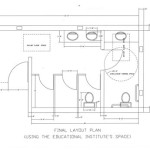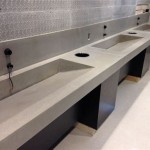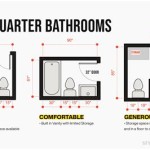Cost to Install Ceramic Tile in Bathroom Floor: A Comprehensive Guide
Installing ceramic tile in a bathroom floor is a popular home improvement project, offering a durable, water-resistant, and aesthetically pleasing surface. However, a clear understanding of the associated costs is essential for effective budgeting and planning. This article provides a detailed breakdown of the various factors influencing the overall cost of ceramic tile floor installation in a bathroom.
The total cost of installing ceramic tile in a bathroom floor typically ranges from $5 to $15 per square foot, encompassing both materials and labor. This range can fluctuate significantly based on factors like the type of tile, the size of the bathroom, the complexity of the installation, and the geographical location. Understanding these factors is crucial for obtaining an accurate estimate and avoiding unexpected expenses.
Factors Influencing Material Costs
Material costs constitute a significant portion of the total installation expense. The primary component, the ceramic tile itself, varies widely in price depending on several characteristics. These include the tile's size, design, quality, and origin. Smaller tiles generally require more grout and labor, potentially increasing overall costs. Intricate patterns or imported tiles will naturally carry a higher price tag compared to standard, readily available options.
The quality of the tile is another crucial determinant of cost. Premium-grade ceramic tiles, known for their durability and resistance to chipping and cracking, will command a higher price. Conversely, lower-grade tiles may be more affordable upfront but could necessitate more frequent repairs or replacements in the long run, potentially negating any initial savings. It is advisable to carefully consider the long-term value and suitability of the tile for a bathroom environment, which is subject to moisture and temperature fluctuations.
Beyond the tiles themselves, other essential materials contribute to the overall cost. These include thin-set mortar, grout, sealant, and potentially underlayment. Thin-set mortar, used to adhere the tiles to the subfloor, comes in various formulations, with some offering enhanced adhesion for specific tile types or subfloor materials. Grout, which fills the spaces between the tiles, also varies in price based on its composition, color, and resistance to stains and mildew. Sealant is necessary to protect the grout from moisture penetration and staining, and its quality directly impacts its longevity. Underlayment may be required if the existing subfloor is uneven or unsuitable for tile installation, adding another layer to the material costs.
The quantity of materials needed will also depend on the size and layout of the bathroom. Larger bathrooms require more tiles, mortar, and grout. Intricate layouts, with numerous corners and angles, may necessitate more cuts and waste, leading to a higher material bill. It is always prudent to purchase slightly more material than initially estimated to account for potential breakage, errors, and future repairs.
Factors Influencing Labor Costs
Labor costs represent the other substantial component of the total installation expense. The hourly rate charged by tile installers can vary widely based on their experience, expertise, geographic location, and the complexity of the project. Highly skilled and experienced installers, particularly those specializing in intricate tile patterns or custom designs, will typically command higher rates.
The complexity of the installation significantly impacts labor costs. Simple, straightforward installations in bathrooms with regular shapes and level subfloors will generally be less expensive. However, installations involving intricate patterns, mosaic tiles, or custom cuts will require more time and skill, leading to higher labor charges. Preparation of the subfloor is also a crucial factor influencing labor costs. If the existing subfloor is uneven, damaged, or requires reinforcement, the installer will need to spend additional time and effort to prepare it adequately, resulting in increased labor expenses. This may involve leveling the subfloor with a self-leveling compound, repairing cracks or damages, or even installing a new underlayment.
The location of the bathroom within the house can also affect labor costs. Bathrooms located on upper floors or in difficult-to-access areas may require the installer to spend more time and effort transporting materials and equipment, potentially increasing the overall labor charges. Accessibility and parking availability can also play a minor role in influencing labor costs.
Furthermore, the removal and disposal of old flooring adds to the labor cost. This process can be time-consuming and labor-intensive, particularly if the existing flooring is difficult to remove or contains hazardous materials like asbestos. In some cases, homeowners may choose to handle the removal themselves to reduce costs, but this should only be done after proper assessment and with appropriate safety precautions.
Additional Costs to Consider
In addition to material and labor costs, several other expenses can impact the overall cost of installing ceramic tile in a bathroom floor. These additional costs should be factored into the budget to avoid unpleasant surprises.
One common additional cost is the replacement of fixtures. If the toilet, vanity, or other bathroom fixtures need to be removed and reinstalled during the tiling process, this will typically incur additional charges. The complexity of removing and reinstalling these fixtures can vary depending on their design and plumbing connections, potentially impacting the overall cost.
Another potential expense is plumbing modifications. If the existing plumbing needs to be altered to accommodate the new tile floor, this will require the services of a licensed plumber, adding to the total cost. Plumbing modifications may be necessary if the existing drain is not properly positioned or if the new tile floor raises the floor level significantly.
Unexpected repairs can also contribute to additional costs. During the installation process, hidden problems with the subfloor or plumbing may be uncovered, requiring unexpected repairs. For example, rot or water damage in the subfloor may necessitate replacement of damaged sections, adding to both material and labor costs. It is advisable to set aside a contingency fund to cover such unforeseen expenses.
Permitting fees may also be required, depending on local building codes and regulations. Some municipalities require permits for tile installation projects, particularly if they involve significant alterations to the structure or plumbing. It is important to check with the local building department to determine if a permit is required and to factor the cost of the permit into the budget.
Finally, consider the cost of disposing of old flooring and waste materials. Some contractors include disposal fees in their estimates, while others may charge extra for this service. If the homeowner is responsible for disposal, they will need to factor in the cost of renting a dumpster or taking the materials to a landfill.
In summary, accurately estimating the cost of installing ceramic tile in a bathroom floor requires careful consideration of various factors. By understanding the material costs, labor costs, and potential additional expenses, homeowners can effectively budget for the project and ensure a smooth and successful installation.

Tile Flooring Installation Cost Floor S Fixr

Ceramic Tile Flooring Installation Cost Fixr

How Much Does Ceramic Tile Installation Cost 2025

Bathroom Flooring Costs In Brookhaven Ga What You Need To Know Ranney Blair Weidmann

What Is The Average Cost To Install Tile Floors Rubi Blog Usa

Ceramic Tile Flooring Installation Cost Fixr

Cost To Tile A Bathroom Floor Average Install Tiles

Ceramic Tile Flooring Installation Cost Fixr

Tile Flooring Installation Cost Floor S Fixr

Budgeting For Tiles Average Cost To Retile Abathroom And Options
Related Posts







